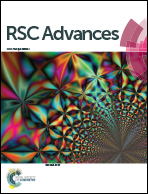Exploring the stability and electronic structure of beryllium and sulphur co-doped graphene: a first principles study†
Abstract
First principles density functional theory (DFT) calculations have been performed to explore the stability, structural and electronic properties of Be and S co-doped graphene sheets. The band-gap of graphene has been tuned by co-doping with beryllium and sulphur at different sites. The results show that by co-doping graphene with Be and S, the band-gap increases from zero up to 0.58 eV depending on the doping sites. The cohesive and formation energies of the systems were also determined. All the isomers formed by exploring different doping sites differ notably in stability, bond length and band-gap. Nevertheless, the planar structure of all the systems investigated was preserved even after geometry optimisation. The majority of the isomers that correspond to co-doping at non-equivalent sites favour higher band-gap opening, but lower stability, than the other set of isomers with equivalent doping sites. Bader charge analysis was adopted to account for charge distribution in the systems. As a result of the difference in electronegativity among carbon atoms and the impurities, it was observed that electron accumulation occurred more on the carbon atoms in the proximity of Be and S than at any other position in the graphitic systems investigated.


 Please wait while we load your content...
Please wait while we load your content...